Hello, everyone,
I recently received two pieces of M.2 A+E key type product of the Coral edge TPU.
Then, I evaluated these on three different platforms, amd64 (Ryzen5 3600 + X570 Chip set), Rock3A and Rock Pi 4B with M.2 A+E key to M key converter.
Please refer to the following picture ,
.
The results of evaluation on tensorflow lite at the Coral web site (https://coral.ai/docs/m2/get-started/) are below,
** Rock pi 4B (Armbian bullseye kernel 5.15-50-rockchip64) **
python3 examples/classify_image.py
–model test_data/mobilenet_v2_1.0_224_inat_bird_quant_edgetpu.tflite
–labels test_data/inat_bird_labels.txt
–input test_data/parrot.jpg
----INFERENCE TIME----
Note: The first inference on Edge TPU is slow because it includes loading the model into Edge TPU memory.
22.9ms
3.9ms
3.9ms
3.8ms
3.8ms
-------RESULTS--------
Ara macao (Scarlet Macaw): 0.75781
** Rock 3A Debian 10 kernel 4.19-106**
----INFERENCE TIME----
Note: The first inference on Edge TPU is slow because it includes loading the model into Edge TPU memory.
17.6ms
5.0ms
4.1ms
3.8ms
4.0ms
-------RESULTS--------
Ara macao (Scarlet Macaw): 0.75781
** amd64 ( Ubuntu 20.04 on Vmware)**
----INFERENCE TIME----
Note: The first inference on Edge TPU is slow because it includes loading the model into Edge TPU memory.
11.6ms
2.6ms
2.6ms
2.6ms
2.6ms
-------RESULTS--------
Ara macao (Scarlet Macaw): 0.75781
I found that the performance was great on the amd64 , however similar results were obtained on very small SBCs.
I thought the Rock 3A is the best platform for a compact AI system.
Thank you for reading this evaluation.


